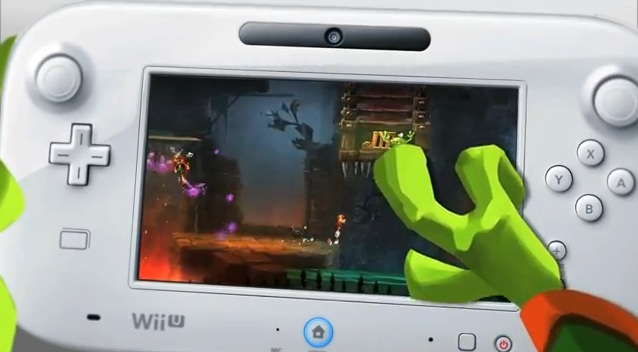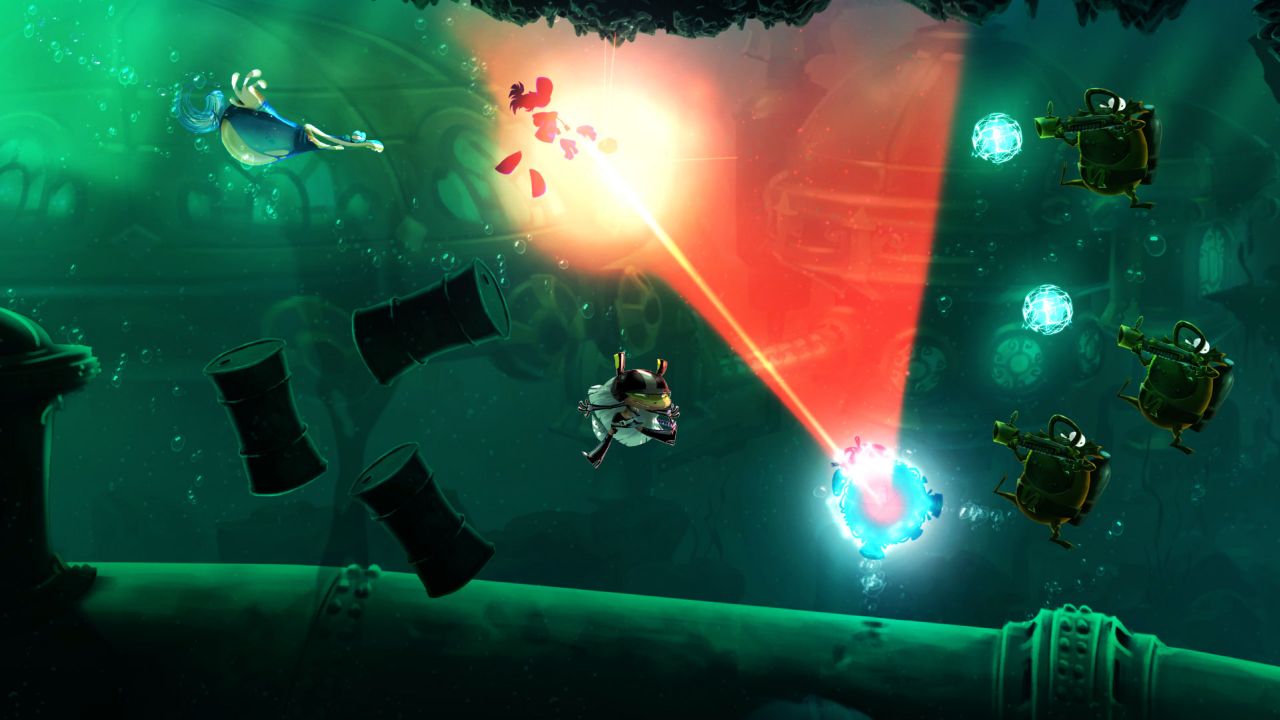Bard’s Tale
(note: This review was written entirely based on the Wii U version of the game. Discrepancies between versions are very minimal, but the Wii U is still the most complete, definitive version of the game.)
My fellow HPP writer Andrew and I are now roommates, and as such, we often discuss the games we’re currently playing. In discussing Rayman Legends, I asked him if he could think of any complaints about the game. After a moment of reflection, he said “It’s…too…good.” Imagine the horror felt from my perspective, hearing my friend speak the exact same conclusion I had already come to in regards to the game. Rayman Legends lives up to its name perfectly, as an adventure truly worth passing down through time.
The Wii U has not exactly gotten a fantastic reputation in its ten months on the market, and Rayman is actually partially responsible for this. Originally planned for release in February exclusively for Wii U, the game’s release was pushed to September a mere two weeks before its intended launch. The reason for this wasn’t to fine-tune the game or add more content, but so they could also release it on Xbox 360, PS3, and PC. The game was still originally designed for Wii U, though, and it seems that remains its true home. I personally played the game on the Wii U, so take that for what it’s worth.
But let’s not get ahead of ourselves here. Every epic tale needs the right place to start, does it not? Like it’s predecessor, Rayman Origins, Legends is not exactly imbued with a great and complex story. Evil falls once again upon the glade of dreams, and Rayman and his friends must be awoken to rid the land of evil once again, only this time with a heavy dose of badass epic adventure. Really, this is all the story we need in a game like this, because once you start playing, the experience is driven along like a veteran air force pilot flying an airplane.

Intuitive platforming hooks you in neatly, gracefully, and instantly.
The thing about Rayman Legends, and Origins for that matter, that I think is most worth appreciating is how it looks in motion. Each level is a machine, and in order to best it, you must become an operative part of that figurative machine. Precision, speed, and timing are the make-or-break elements of Rayman Legends, and they give the player a feeling of exhilaration I have never felt from another 2D platformer. You actually feel like you’re learning about how these kinds of games are made, and I honestly feel like a more intelligent and educated gamer because of it.
Gameplay in Rayman Legends is a simple affair, and does everything it needs to function perfectly. You walk, run, glide, punch, and swim your way through the game, a combination of elements all available from the start. All the tools to beat the game are available from the get-go, and it’s up to you to understand them all, a task that feels smooth and intuitive. There’s a lot of wall-jumping and even wall-running, and you quickly find yourself working with some Assassin’s Creed-level parkour skills to work your way through the levels.

Looks like pandemonium, feels like a skill to be learned.
Rayman is an exercise is intuitive level design, and does so through use of creative concepts. Each of the game’s five worlds is themed around a different kind of epic adventure, from your classic medieval swords-and-dragons fare to creative undersea adventure and Greek Mythology-themed worlds later on. Each world’s blanket concept has a ton of potential, and none disappoint in the slightest. I could try and make a quick list of three or four examples, but I honestly can’t choose so few when there are so many great ideas at work. And what’s great is that none of these ideas are reused beyond their welcome.
One element of gameplay that proved problematic in the translation of the game onto other consoles is the issue of Murphy. One of Rayman’s evil-fighting buddies, Murphy the fly operates on the Wii U gamepad as a sort of assist player, moving obstacles, changing parts of the environment, and even shooting at fiece dragons to help his friends get through. When playing multiplayer, One regular player plus one player as Murphy is really the way to go, as it gives players a legitimate form of multiplayer platforming without the jumble of having a bunch of players running around on the same screen. Even when you do have more than one player on the main screen, though, there isn’t really much of a conflict between players. If you’re playing the game single-player, there are a couple levels in each world that require you to play as Murphy, which raised concern before the game’s release. But your tasks on the touchscreen are much more varied than, say, playing with the gamepad’s touch controls in New Super Mario U. Every time I was prompted to switch to Murphy, I met it not with a groan, but with eagerness to see what would be in store this time.

Gamepad use comes in healthy but occasional doses, but can be enjoyed throughout the game if that’s more your style.
Rayman Legends is an epic tale in every sense, and presentation is no exception. It maintains the visually vibrant and gorgeous look of Origins, but tones down the color and cartoonishness just a bit, while adding illustrative detail to characters and environments. Every hand-drawn level has its own distinctive look, enhanced by a musical score every bit as catchy and unique as we’ve come to expect. Where visuals and music truly come to meet, fall in love, and get kinky, is in the music levels. Each of the game’s five worlds ends with a rythym-based music level using music from outside the game, from rock classics like Eye of the Tiger to some awesome symphonic stuff. Each of these is a challenge in timing and precision, which, as we’ve already made clear, is what the game is really about as a whole. An unlockable sixth world gives players not only an additional music level, but challenging 8-bit remixes with visuals restyled with static and the curve of an old LCD TV monitor. If you want to sell someone on Rayman Legends, sit them down and have them play, or at least watch you play, one or two of these levels. If they’re not sold on the game instantly, let me know, and I shall throw down my proverbial reviewer’s cap forever.
Something that gets mentioned a lot when discussing 2D platformers getting a full retail release is value, or more accurately, “bang for your buck”. Somehow a lot of gamers feel that 40 levels of ingenious design is not enough for their money. But even if you are one of those people, Legends has a lot for you. Each and every level has two different kinds of time trial versions, one involving pure speed and the second adding an opponent to race against. There are also various unlockable characters, all princesses of the worlds in which they are found, who are obtained through a whole other type of temple run-esque level. And as if all that wasn’t enough, as you progress you can even unlock visually remastered levels from Rayman Origins. All of these levels sport Legends’ newer visual style, giving new life to over 30 levels from 2011’s best platformer. Each and every one of these various level types has teensies to save and lums to collect, rendering the entire game a completionist’s dream. The Wii U version also sports the continuation of daily challenges ala the app released a few months back, giving dedicated gamers reason to keep coming back even after completing each and every level.
What I love most about Rayman Legends, I think, actually stems from the above mentioned amount of content. If I play a game that offers me a potential 40+ hours of content, I want it to take place across an arsenal of new, vibrant and unique areas. It’s why I loved Xenoblade Chronicles, and why I could never get into Skyrim. And it’s something Rayman Legends does perfectly. If you’ve ever spent a day or weekend marathoning a season of a TV show, you know as well as I do the feeling of “Oh, just one more. I have to see what happens next!” In that vein, playing Rayman Legends is like watching Doctor Who. Each level has its own inventive idea, from using Murphy to eat a pathway through a mountain of cheese to maneuvering your way up the inside of a tower as it quickly sinks into quicksand, and each is gripping in its own right, while still leaving you with that thought of “well, now I HAVE to see what’s next”. You will find yourself running through the forest, into the sea, through ancient temples and a perplexing maze, and finally soaring into the sky before you are through. If I were asked to choose a favorite level of Rayman Legends, I would be hard pressed to do so when almost every single level in the game stands out so completely.

Never will you play two levels in a world and think they felt “too alike”.
Rayman Legends is a combination of elements that far exceed expectations in every way. It’s like taking ten different bright colors of paint and smearing them all together, but instead of getting an awkward brownish-grey, getting a new color unlike anything you’ve ever seen. The use of Murphy keeps multiplayer smooth, fun, and truly the best way to play, while not feeling stale or intrusive in single-player due to the variety of challenges and tasks you face. The game’s worlds are unique and inventive, never ceasing to surprise, and the music levels marry rhythm gaming and platforming in a way I can only describe as more goddamn magical than reading through all seven Harry Potter books in a single sitting. While wearing a wizard hat. With an owl on your shoulder. What I’m saying is it’s very magical. This game will make you an actual wizard. Continuing to breathe new life into the 2D platforming genre with absolute perfection, Rayman Legends gets 5 grand epics out of 5.
Final Verdict: 5/5
Available on: PC (Reviewed), PS3, PS4, Xobox 360, Xbox One ; Developer: Ubisoft ; Publisher: Ubisoft ; Released: 29 August 2013 ; Players: 1
















